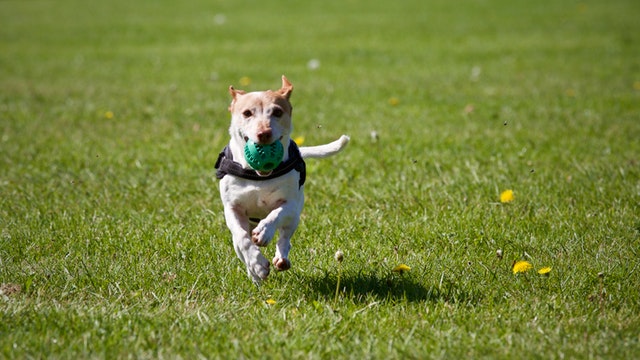All dogs love to jump around and play outside. As a dog owner, you already know that your dog loves going out and taking you for a walk. When your dog suddenly becomes unsteady on its feet, and your dog looks like it was drunk, that may seem bad and disturbing.
What is Ataxia in dogs? That is the question behind this little story. Loss of balance in dogs is another way to call it instead of Ataxia! When there is a problem with the dog’s central nervous system and the communication between the brain and other parts of the body becomes unstable, Ataxia happen!
Ataxia in dogs is an annoying condition that affects your dog lifestyle, and it may become the reason your dog can’t enjoy its time outside as before! So, what is Ataxia in dogs!

Table of Contents
What Is Ataxia In Dogs?
Ataxia is a condition where there is sensory dysfunction that leads to loss of coordination of the limbs, head, and/or trunk.
Whatever the reason causes Ataxia in dogs, there are three types of it, Sensory, Vestibular, and Cerebellar. All of these types can be noticed as changes in the coordination of the limbs. However, if the condition is Vestibular or cerebellar, you would also see changes in the head and neck movement.
To understand this much better, let’s learn more details about these types.
If we start with Cerebellar and Vestibular Ataxia, then we are talking about problems in the limbs as well as the head and neck.
Cerebellar Ataxia is seen as an uncoordinated motor activity of the limbs by noticing taking more giant steps or stepping oddly. Also, you will notice some uncoordinated movements of the neck and head.
Alongside these changes, you may notice inadequate in the strength of the body, tremors, and swaying of the torso.

As for the Vestibular Ataxia, the problem is related to the vestibulocochlear nerve. This nerve responsible for the balance of the body, and it carries these nerve signals from the inner ears to the brain. If any damage happens to this nerve, then we got a “balance problem of the body.”
Once the damage occurs to the nerve, the dog starts to feel a false sense of movement. Some changes begin to happen to the head and neck position, as well as the hearing.
Also, you will start to see some visible signs such as falling without reason, tipping, rolling over, and leaning. Some other symptoms, such as changes in eye movements, drowsiness, coma, weakness in legs, and sensory deficiencies, maybe noticed too, and they are related to the central vestibular changes.
As for the peripheral vestibular changes, you may see some changes in your dog’s mental status, vertical eye movements, and some central vestibular signs.
The third type is called Sensory (proprioceptive) Ataxia. This type typically occurs due to compression on the spinal cord, and it is a slow compression over time. The signs and symptoms you may notice are related to the limbs only, such as weakness of the limbs, and it is progressive, and misplacing the limbs.

Causes Of Ataxia In Dogs
Various causes are depending on the type of the Ataxia, to make it simple, we will talk about the causes of each type.
1. Neurological Causes
- Degenerative:
- Abiotrophy (prematurely the cerebellum loss function)
- Cerebellar
- Cancer
- Tumors in the head
- Inflammatory, unknown causes, immune-mediated.
- Anomalous:
- Underdevelopment is secondary to perinatal infection.
- A cyst located near the fourth ventricle.
- Toxic
- Head trauma
2. Vestibular – Central Nervous System (CNS)
- Inflammatory, unknown causes, immune-mediated
- Toxic
3. Vestibular – Peripheral Nervous System
- Metabolic
- Cancer
- Traumatic
- Infectious:
- Middle ear
- Fungal
- Diseases of unknown cause

4. Metabolic Causes
- Anemia
- Electrolyte disturbances such as Low levels of calcium, potassium or glucose
- Hypothyroidism
- Thiamine deficiency
5. Spinal Cord Causes
- Infectious: eg: Infection of the vertebrae
- Traumatic
- Cancer
- Vascular:
- Loss of blood to the nervous system due to blockage of blood vessels by a blood clot
- Anomalous:
- Spinal cord and vertebral malformation
- spinal cyst
- Degeneration of the nerve roots and spinal cords
6. Other Causes
- Blood circulation issues (such as heart disease)
- Respiratory diseases
- Metronidazole toxicity
- Infections affecting the brain or brain stem (such as canine distemper virus)

Signs And Symptoms Of Ataxia In Dogs
There are different symptoms, as we mentioned above, depending on the type of Ataxia. You may see one or many of these signs if your dog has this condition but to sum them up, these signs may include one of these:
- Head tilting
- Deafness or loss of hearing
- Weakness in one or more limbs
- Tremors
- Abnormal behaviors
- Strange eye movements
- Dizziness
- Stumbling or swaying
- Drowsiness
- Nausea from a disruption in equilibrium
- Loss of appetite
Diagnosis Of Dog’s Ataxia & Loss Of Balance In Dogs
Your veterinarian will be by asking you some questions about what happened and how it happened. So, you need to tell them everything and give them a thorough history of your dog’s health and every detail about all the symptoms and signs you noticed.
Also, if you remember any incident that may have preceded this problem, you should tell that to your vet as it may the cause of this condition.
After that, your veterinarian will ask for some blood tests and chemical profiles. Also, your vet will ask for radiological imagings to be able to determine the location of the disease. This radiological imaging may include Myelography CT, MRI, and/or X-ray.

If your veterinarian suspects cancer or infection, they may ask for Chest X-ray to determine that. Also, they may perform an ultrasound for the abdomen to check the internal organs such as your dog’s kidney, liver, and pancreas.
Your vet will perform another test if they suspect an infection in the nervous system, which is a sample of the cerebrospinal fluid (CSF) for lab analysis.
All these tests plus physical examination with the history will tell your vet the reason causing Ataxia in your dog. By knowing the reason for this condition, your vet can give you the best approach for the treatment.
Treatment of Ataxia in Dogs
The treatment starts after your veterinarian determines the underlying cause of Ataxia in your dog. The treatment usually is outside the clinic unless Ataxia becomes a life-threating condition.
Depending on the cause, the approach starts; if the reason is related to a deficiency of something inside the body, supplements are the best approach by providing your dog supplement nutrition with calcium, glucose, potassium.
If the cause is Toxicity, infection, or inflammation, some medications and antibiotics may be given to fight this problem. Also, surgery may be an option if the cause is a tumor or cancer.
Sometimes, surgery to remove tumors or to correct abnormalities may even be necessary.
However, due to the nature of the problem, physical rehabilitation is a choice and part of the treatment so your dog can get better and improve the overall physical condition.

Prevention Of Ataxia In Dogs
The only thing you can do to protect your dog is to pay attention to the causes and try to prevent some of them from happening, such as ear infections. If you make sure to treat the problem and keep your dog-ear clean all the time, that will increase the likelihood of not getting worse and damage the nerve inside the inner ears.
You don’t have to sweat about this condition and overthink it. All you can do is to help your dog as soon as possible to avoid further damage. Whatever the problem your dog facing, just try to solve it fast, like that you will prevent complications such as Ataxia!
Conclusion
Ataxia for dogs can be annoying to deal with, for both you and your dog. Unfortunately, some of the conditions and problems that happen to us and our fluffy friends don’t have a cure or a way to treat 100%. All we can do is to protect our fluffy friends from having more damage from these problems.
Ataxia in dogs has many causes and depending on the cause the type is different. According to this, each type of Ataxia is reflected in different signs and symptoms. Some symptoms of ataxia in dogs are similar in all types but others are different depends on the location of this disease.

So finally, I hope you found this article useful and informative. Let me know your answer. What do you think? Do you have more information or tips about Ataxia in dogs? Write them down below.
If you have any other questions or different opinions about it, leave a comment below.
Today’s Quote:
“Did you ever notice that when you blow in a dog’s face he gets mad at you? But when you take him in a car, he sticks his head out the window.” — Steve Bluestone
You’ll Also Love These Posts:
Studies have shown if you like this blog article — you will also love the following posts.


This is a really interesting article and I’m sure many dog owners will benefit from this knowledge. I’d never heard of ataxia, but can understand how the inner ear can affect balance. There seems to be quite a few causes for this condition, but thankfully most seem treatable.
Hey Kathy,
I agree with you, knowing and reading is a powerful way to protect our fluffy friends. Ataxia in dogs can be annoying conditions that interferes with the normal life of our fluffy dogs. Knowing the cause can help the vet to treat it and therefore get rid of this condition.
Hi,
Thanks for taking the time to write this article, you’ve covered ataxia from every angle.
I’m concerned about my little dog who is 7 years old. Reading through your descriptions of the various types of ataxia, I’m wondering if this is an issue for her.
She had an ear infection which was only noticed last week when I took her for a trim at the dog parlour. The girl there found it, and cleaned her ears.
Her ears seem fine now, but I notice that she has been shivering for the past few days. You mentioned that dogs sometimes have tremors with this condition, so what I thought was my dog feeling cold may be more serious.
I’ve also noticed that she’s been more tired than normal, which you list as a sign. She didn’t want to take her walk this morning.
I’m going to take her to the vet tomorrow, so that she can be properly assessed.
Thanks again for alerting me to the possibily of ataxia following an ear infection. I’m hoping that antibiotics will be all she needs.
Hey Judy,
First, I hope your doggie gets better fast and I hope nothing harmful is there. These signs you noticed maybe early signs for Ataxia or any other disease. As I said, there many diseases and conditions that share the same signs and symptoms, taking your dog to the vet to assess the condition is a smart move. I am glad my article was helpful for you to understand what is going on and open some new thoughts for you to protect your dog and keep her healthy.